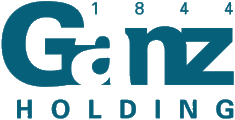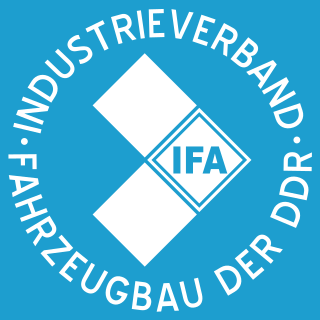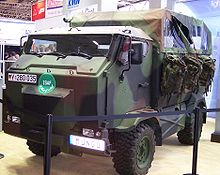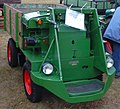
The Ford Transit is a family of light commercial vehicles manufactured by the Ford Motor Company since 1965, primarily as a cargo van, but also available in other configurations including a large passenger van, cutaway van chassis, and a pickup truck. The vehicle is also known as the Ford T-Series, a nomenclature shared with Ford's other light commercial vehicles, the Ford F-Series trucks, and the Ford E-Series chassis. As of 2015, 8 million Transit vans have been sold, making it the third best-selling van of all time and has been produced across four basic platform generations, with various "facelift" versions of each.

Magirus GmbH is a truck manufacturer based in Ulm, Germany, founded by Conrad Dietrich Magirus (1824–1895). It was formerly known as Klöckner Humboldt Deutz AG, maker of the Deutz engines, so the brand commonly used was Magirus Deutz, and for a short time Klöckner. Most trucks from Magirus were also known as Magirus-Deutz. The logo of Magirus Deutz was a stylised M with a sharp, long centre point to represent the spire of Ulm Minster.

The Ganz Machinery Works Holding is a Hungarian holding company. Its products are related to rail transport, power generation, and water supply, among other industries.

Waltershausen is a town in the south-western part of the district of Gotha in the state of Thuringia, Germany.
Multijet is Stellantis's term for its current common rail direct injection turbodiesel engine range. Most of the Fiat, Alfa Romeo, and Lancia range, as well as certain Chrysler, RAM Trucks, Jeep, and Maserati vehicles, are equipped with Multijet engines. Ownership of some Fiat Multijet designs is shared with General Motors as part of a settlement of the failed merger between the two auto conglomerates. The GM Powertrain Torino group in Turin, Italy, manages its interest in these engines. Some PSA Peugeot Citroën diesel engines are also rebadged JTD units, and vice versa. Fiat's common-rail diesel engine is also known as JTD, an initialism of Jet Turbo Diesel.
Maschinenbau Kiel GmbH was a German company that designed, manufactured and marketed marine diesel engines, diesel locomotives and tracked vehicles under the MaK brand name. The three primary operating divisions of Maschinenbau Kiel GmbH were sold to different companies in the 1990s.
Bedford Vehicles, usually shortened to just Bedford, was a brand of vehicle manufactured by Vauxhall Motors, then a subsidiary of multinational corporation General Motors. Established in April 1931, Bedford Vehicles was set up to build commercial vehicles. The company was a leading international lorry brand, with substantial export sales of light, medium, and heavy lorries throughout the world.

Industrieverband Fahrzeugbau, usually abbreviated as IFA, was a conglomerate and a union of companies for vehicle construction in the former East Germany.

Robur was a marque of the Volkseigener Betrieb VEB Robur-Werke Zittau of East Germany (GDR). It mainly produced 3-ton trucks. The vehicles were mainly produced in the town of Zittau in what now is South-East Saxony. Until 1946, company produced under the marque Phänomen, and until 1957 under the name VEB Phänomen Zittau.

Ludwigsfelde is a town in the north of the district Teltow-Fläming in Brandenburg.

The Medium Tank T20, Medium Tank T22 and Medium Tank T23 were prototype medium tanks, developed by the United States Army during World War II. They were designed as successors to the M4 Sherman. The standard main weapon for production versions of these designs was to be the 76 mm M1.

ENASA was a Spanish motor vehicle manufacturing company that was incorporated in 1946 after having bought the automotive assets of the Spanish Hispano-Suiza and the Italian Fiat in Spain. It produced trucks, buses and military armored vehicles under the Pegaso and, for a short while, Sava brands. ENASA belonged to INI, a Spanish state-owned industrial holding company.

Hispano-Argentina was an Argentine automotive and engineering company that manufactured automobiles, military vehicles, engines, weaponry, and parts for public works.

The Land Rover Series I, II, and III, or simply the Land-Rover are compact British off-road vehicles, produced by the Rover Company since 1948, and later by British Leyland. Though inspired by the World War II jeep, the Land Rover immediately distinguished itself from all other cars. From launch, it was the first mass-produced civilian four-wheel drive car with doors, and an available hard roof. Contrary to conventional car and truck chassis, it used a sturdier fully box-welded frame. Furthermore, due to post-war steel shortage, and aluminium surplus, Land Rovers received non-rusting aluminium alloy bodies, favouring their longevity. In 1992, Land Rover claimed that 70% of all the vehicles they had built were still in use.
Audi Sport GmbH, formerly known as quattro GmbH, is the high-performance car manufacturing subsidiary of Audi, itself a subsidiary of the greater Volkswagen Group.

The United States has produced tanks since their inception in World War I, up until the present day. While there were several American experiments in tank design, the first American tanks to see service were copies of French light tanks and a joint heavy tank design with the United Kingdom.

Industriewerke Ludwigsfelde is an automotive factory in Ludwigsfelde in Brandenburg, just south of Berlin in Germany. The factory is part of Daimler AG and since 1991 it has made Mercedes-Benz vans. It is also the producer of the Multicar line of automobiles.

The Ford Southampton plant was a motor vehicle assembly plant, located in Swaythling on the north eastern outskirts of Southampton, England. It was the western European centre for production of the Ford Transit van. The last vehicle was produced on 26 July 2013, ending Ford's vehicle assembly operations in the UK.
The 44M Tas was a Hungarian heavy tank/medium tank design of World War II. It was developed to combat heavily armored Soviet tanks encountered on the Eastern Front and to replace the older Turán I and Turán II tanks which Hungary operated, modernising Hungary's armoured forces. The Tas somewhat resembled the German Panther tank in terms of both looks and capabilities. It was to be well armored – up to 120 mm thick and with sloped armor. The main armament would likely have been a Hungarian built heavily modified anti-tank version of the 80 mm Bofors AA gun. The only prototypes built were destroyed when the Americans bombed the Weiss Manfréd factory in July 1944.

Hako GmbH is a manufacturer of street sweeping equipment and ultra-light commercial vehicles, headquartered in Bad Oldesloe, Germany with customers in about sixty countries. The company was founded on 24 December 1948; its name derives from Hans Koch & Sohn. It produces the Multicar line of vehicles.


























